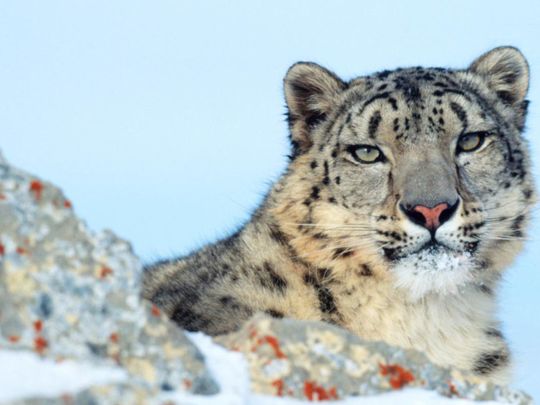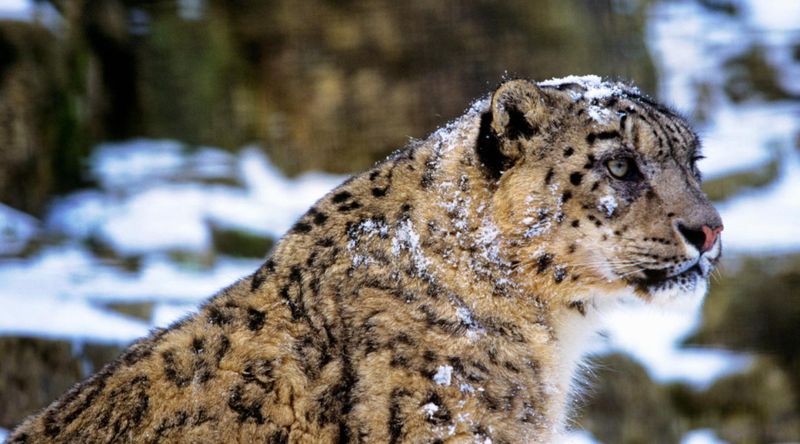
NEW DELHI: Snow leopards have been dubbed the “ghosts of the mountains” for their elusive behaviour, but Indian researchers have successfully photographed more than 200 in a landmark study estimating at least 718 across the country.
The mammoth five-year survey, the first nationwide review of snow leopards in India, monitored 120,000 square kilometres (46,000 square miles) of their remote mountain habitat, according to the environment ministry.
It involved setting out camera traps in nearly 2,000 locations recording more than 180,000 nights — the equivalent to nearly 500 years — to record 241 individual leopards on camera.
Also read
- Saudi National Center for Wildlife releases endangered species in Ibex Protected Area near Riyadh
- US: Possible ‘first’ sighting of newborn great white shark off California
- How Dubai thrives as a biodiversity hotspot despite the desert environment
- Elephants on the loose, South African rangers on the chase
The leopards — with thick grey fur dotted with dark spots, and large paws that act as natural snow shoes — are “masters of stealth and camouflage”, according to the World Wide Fund For Nature (WWF) India, who assisted the assessment.
The environment ministry said the survey has “significantly increased understanding” of the rare creatures, Indian media reported on Wednesday.
THEIR MAIN PREY: Snow leopards feed on the ibex, Himalayan tahr, marmot, pika, hares, small rodents and game birds. In Nepal, the snow leopard’s main prey - blue sheep which are not bluw - will provide one animal with food for a week.
HIGH ALTITUDE ACROBATS: Snow leopards live in high-altitude mountainous terrain, usually at elevations of 3,000-4,500m. They prefer steep, broken landscapes such as cliffs, rocky outcrops and ravines. Snow leopards have short forelimbs and long hind legs, which allow them to traverse and stay agile in their steep and rugged environments.
THEY CAN’T ROAR: Unlike other big cats, snow leopards can’t roar. Snow leopards have a ‘main’ call described as a ‘piercing yowl’ that’s so loud it can be heard over the roar of a river.
THEY’RE MORE CLOSELY RELATED TO TIGERS THAN THEY ARE LEOPARDS: Despite being called the snow ‘leopard’, this big cat is more closely related to the tiger than the leopard.
THEIR PAWS ACT AS NATURAL SNOWSHOES: The wide, fur-covered paws of a snow leopard serve as natural snowshoes, helping to distribute its weight over soft snow and protect it from the cold.
THEY CAN NEARLY COVER THE DISTANCE OF A MARATHON IN ONE NIGHT: Snow leopards can travel over an incredible 25 miles in a single night.
THEY’RE WELL DISGUISED: Snow leopards are really well camouflaged! Their long fur and less distinctive markings that seem to change shape with body movement make identifying individual snow leopards difficult compared to other big cats like tigers, leopards and jaguars, which have more distinctive markings.
LONG JUMP CHAMPIONS: The snow leopard would do well in most athletic events, it’s best potentially being the long jump. Some snow leopards have been known to leap up to 9 metres — 6 times their body length!
THEY’RE UNDER THREAT FROM HUMAN ACTIVITY: There could be as few as 4,000 leopards in the wild, however the exact number is unknown as they are extremely elusive. The main threats they face are habitat loss and deterioration, human-wildlife conflict, loss of prey, poaching for the illegal trade, and climate change. As a result, snow leopards really need our help, WWF is working alongside communities, Governments and other organisations to address some of the threats snow leopards face.
Source: WWF, UK
Snow leopards, scientific name panthera uncia, are listed as “vulnerable” species by the International Union for Conservation of Nature (IUCN).
Before the survey, the WWF had suggested that there were between 400-700 snow leopards in India. The report now puts the total number in the upper range of earlier estimates.

Two-thirds of the cats are found in India’s far northern Ladakh, with the rest in Himalayan states including Uttarakhand and Himachal Pradesh, the survey found.
“Consistent monitoring is essential to ensuring snow leopards’ long-term survival,” the environment ministry added.

The Snow Leopard Trust, a US-based conservation group, says the exact total number is not known but that “there may be as few as 3,920 and probably no more than 6,390” across 12 countries in Asia.
The IUCN has dubbed the solitary cat the “ghost of the mountains” for its ability to hide, noting numbers are “decreasing mostly due to habitat loss, poaching, and the impacts of climate change”.












